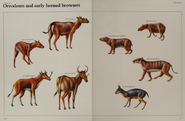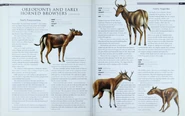| Protoceras | |
|---|---|

| |
| A historical restoration of Protoceras celer | |

| |
| A skeleton of Protoceras celer | |
| Scientific classification | |
| Kingdom: | Animalia |
| Phylum: | Chordata |
| Class: | Mammalia |
| Order: | Artiodactyla |
| Family: | †Protoceratidae |
| Genus: | †Protoceras Marsh, 1891 |
| Type species | |
| †Protoceras celer Marsh, 1891 | |
| Referred species | |
| |
Protoceras (meaning "first horns") is an extinct genus of protoceratid endemic to North America from the Oligocene through Miocene (Orellan to Harrisonian stage) 33.9—20.6 Ma, existing for approximately 13.3 million years.
Taxonomy[]
Protoceras was named by Marsh (1891). Its type is Protoceras celer. It is the genus of Protoceratidae and subfamily Protoceratinae. It was assigned to Protoceratidae by Marsh (1891) and Carroll (1988); and to Protoceratinae by Matthew (1908), Webb (1981), Prothero (1998), Webb et al. (2003) and Prothero and Ludtke (2007).
Morphology[]
Protoceras was 1 m (3 ft 4 in) long and resembled a deer in terms of body shape. Like some other protoceratids it had three pairs of blunt horns on its skull. In life these were probably covered with skin, much like the ossicones of a giraffe. Protoceras was sexually dimorphic - females only had one pair of horns (the one on the back of the skull), which was shorter than the same pair in males. Males probably used these horns for display, impressing females and/or intimidating rivals. Due to the orientation of the horns the males probably displayed them sideways instead of frontally.
Body mass[]
Three fossil specimens of Poabromylus were measured by M. Mendoza, C. M. Janis, and P. Palmqvist for body mass.[8] The specimens were determined to weigh:
- Specimen 1: 95.2 kg (210 lb)
- Specimen 2: 57.2 kg (130 lb)
- Specimen 3: 89.8 kg (200 lb)
- Specimen 4: 54.6 kg (120 lb)
Protoceras was one of the earliest and most primitive protoceratids, still possessing upper incisors and four functional toes (later genera had only two functional, hooved toes). Protoceras lived in the deserts of the Late Oligocene, alongside the oreodont Leptauchenia.




